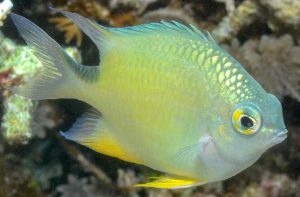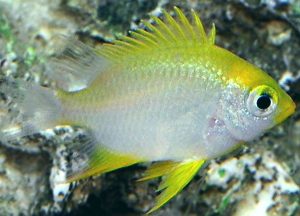Ternate Damselfish (Amblyglyphidodon ternatensis) known to tropical fish keeping enthusiasts as the Lemon Chromis are only found in the Coral triangle region of the Western Pacific from Indonesia to Solomon Islands, north to the Ryukyu Islands (Nansei Islands); and Belau in Micronesia.
Adult Ternate Damselfish are found alone, in pairs, but more often in small groups in the coral rich areas of sheltered coastal reefs among branching Acropora type staghorn coral heads at depts between 3 to over 50 feet where they feed on among the substrate. They are especially abundant around the rock islands in Palau, where they aggregate with Amblyglyphidodon curacao.
Like Azure Damselfish (Chrysiptera hemicyanea); Amblyglyphidodon ternatensis are a non-migratory, reef dependent species that feed on small crustaceans, microalgae, and zooplankton among the substrate during daylight hours, and shelter among the coral branches during the night for protection from predators.
One or two dominant males will usually claim and defend a single branching Staghorn coral with a harem of juveniles and females, and in return for the shelter provided by the coral, remove unwanted algal growth. Dead Acropora coral branches normally serve as a nest for breeding activity.
Adult Ternate Damselfish have a silverish white body color below that turns into a light yellow with a greenish blue hue towards the upper portion. Their pelvic, dorsal, and anal fins are yellow to a faint, almost translucent yellow. The rear dorsal, anal, and caudal fins are mostly translucent.
Some individuals have a small dark splotch on the upper surface of the caudal base. Except for the green hue that offsets the transparent coloration of its fins and tail, the Ternate Damselfish is very similar looking to Yellow Damselfish (Amblyglyphidodon aureus). The yellow pelvic fins on adults distinguish Amblyglyphidodon ternatensis from similar members of the genus. Juvenile Ternate Damselfish and Amblyglyphidodon batunai are very difficult to distinguish from each other.
Odd numbered groups of Ternate Damselfish of at least 9 or more individuals can be housed in a mature FOWLR or reef aquarium of at least 30 gallon capacity with a sand or fine gravel substrate and plenty of live rock arranged into crevices, caves, and overhangs for them to hide among. Ternate Damselfish are completely reef safe and will not disturb corals or invertebrates in a reef tank. Although solitary juvenile individuals will occasionally become territorial towards their own kind or similar sized fish, they will generally ignore other invertebrates, corals, and other fish in a peaceful species tank.
Larger tanks with plenty of live rock are required for keeping large schools of Ternate Damselfish with other peaceful to semi aggressive fish species. Juveniles are generally passive to semi aggressive but can become more territorial as they grow into adults, especially when sufficient hiding places are not available in the tank.
Although Amblyglyphidodon ternatensis have been successfully bred in captivity, their larvae are difficult to rear. Ternate Damselfish follow a benthic egg laying cycle and are well known for laying their eggs on dead coral skeletons or parts from Acropora corals. In their natural habitat, they pair off and spawn in groups. Each pair will claim a small section of the reef where the male cleans off a branch of dead coral for the female to lay her small adhesive eggs.
In the event that an alternate material for spawning isn’t available, a dedicated pair will often remove portions of a live Acropora to make a nest. After a brief courtship ritual, the female will lay a mass of eggs on the coral branch. The male then fertilizes the demersal eggs and will guard and aerate them until the larvae hatch out. The tiny fry in their larval stage will drift with the current as plankton feeding on zooplankton and phytoplankton before settling to the bottom as partially developed damselfish. Males will often mate with multiple females in the group during the spawning season.
Ternate Damselfish are omnivores that need a varied diet of meaty items, herbivore flakes or pellets, and frozen foods to thrive. Live, frozen, or freeze dried brine shrimp, Mysis shrimp
, finely chopped clams, fresh fish, and Spirulina flakes
will all be eagerly accepted. Feeding a varied diet several times a day is recommended to minimize aggression and preserve body coloration.
Although Ternate Damselfish (Amblyglyphidodon ternatensis) are rarely seen in the the aquarium trade; tropical fish keeping enthusiasts can occasionally find them online from wholesalers, trans shippers, and retailers at prices varying from $4.99 to $11.99 at approximate purchase sizes: Small: 3/4″ to 1-1/4″; Medium: 1-1/4″ to 2″.
Minimum Tank Size: 30 gallons
Aquarium Type: Reef or FOLR
Care Level: Easy
Temperament: Semi Aggressive
Aquarium Hardiness: Hardy
Water Conditions: 72-87°F, dKH 8 to 12 , pH 8.1 – 8.4, sg 1.020-1.025
Max. Size: 3″
Color Form: Green, Silver, Yellow
Diet: Omnivore
Compatibility: Reef
Origin:
Family: Pomacentridae
Lifespan: 5 years
Aquarist Experience Level: Beginner




